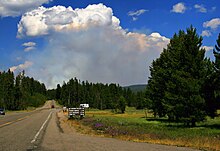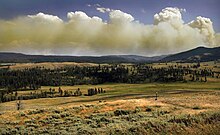Flammagenitus cloud

A pyrocumulus, or fire cloud, is a dense cumuliform cloud associated with fire or volcanic activity.[1]
A pyrocumulus is similar dynamically in some ways to a firestorm, and the two phenomena may occur in conjunction with each other. However, one may occur without the other.
Formation

A pyrocumulus cloud is produced by the intense heating of the air from the surface. The intense heat induces convection which causes the air mass to rise to a point of stability, usually in the presence of moisture. Phenomena such as volcanic eruptions, forest fires, and occasionally industrial activities can induce formation of this cloud. The detonation of a nuclear weapon in the atmosphere will also produce a pyrocumulus in the form of a mushroom cloud which is made by the same mechanism. The presence of a low level jet stream can enhance its formation. Condensation of ambient moisture (moisture already present in the atmosphere) as well as moisture evaporated from burnt vegetation or volcanic outgassing occurs readily on particles of ash.

Pyrocumuli contain severe turbulence which also results in strong gusts at the surface which can exacerbate a large conflagration. A large pyrocumulus, particularly one associated with a volcanic eruption, may also produce lightning. This is a process not fully understood as of yet, but is probably in some way associated with charge separation induced by severe turbulence, and perhaps, by the nature of the particles of ash in the cloud. Large pyrocumuli can contain temperatures well below freezing, and the electrostatic properties of any ice that forms may also play a role. A pyrocumulus which produces lightning is actually a type of cumulonimbus, a thundercloud and is called pyrocumulonimbus. The World Meteorological Organization doesn't recognize pyrocumulus or pyrocumulonimbus as distinct cloud types, but rather classifies them respectively as cumulus (mediocris or congestus) and cumulonimbus.
Appearance

Pyrocumulus is often grayish to brown in color, because of the ash and smoke associated with the fire. It also tends to expand because of the ash involved in the cloud's formation increase the amount of condensation nuclei. This poses a problem, as the cloud can trigger a thunderstorm, from which the lightning can start another fire.
Effects on wildfires
A pyrocumulus cloud can help or hinder a fire. Sometimes, the moisture from the air condenses in the cloud and then falls as rain, often extinguishing the fire. There have been notable examples where a large firestorm has been extinguished by the pyrocumulus that it created. However, if the fire is large enough, then the cloud may continue to grow, and become a type of cumulonimbus cloud known as a pyrocumulonimbus cloud, which may produce lightning and start another fire;[2] however, this cloud type is not differentiated from cumulonimbus by the World Meteorological Organization.
